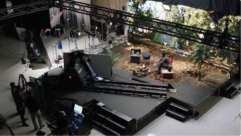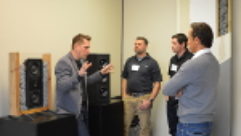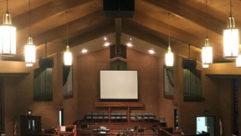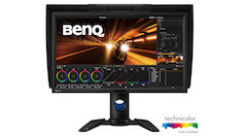Selling Calibration Services
Can you make any money providing a service that customers either don’t know exists, don’t realize they need, or don’t want to pay for because they think someone has already done it? The service is calibration.
CAN YOU make any money providing a service that customers either don’t know exists, don’t realize they need, or don’t want to pay for because they think someone has already done it? The service is calibration, the adjustment of a variety of performance parameters to deliver the best possible results from audio loudspeakers or video displays. It’s a distinctly professional service — the kind of value-added AV integrators cite as a means of differentiating themselves from bargain-price retail outlets. Calibration could be providing revenue for more integrators, if they were more aware of it — and how to sell it.
“It’s a must-do for professionals, but even they don’t know about it,” says consultant Jim Doolittle of Waltham, MA. At the same time, he adds, “people who purchase video displays have no idea calibration exists. They just trust the installer to do the job.”
Doolittle, who is an Imaging Sciences Foundation (ISF)-certified calibration specialist, revives the old joke that NTSC means both “National Television Systems Committee” and “Never Twice the Same Color.” Every time a consumer notices that no two TVs on display look alike, it’s the result of inattention to calibration. “If you want to see the picture as the artist intended it, you have to calibrate,” he says.
Audio systems present the same challenge, particularly in the new environment of digital signal processing and electronically-driven crossovers among speakers, says Jerry Hogerson of Star Enterprises in Anaheim Hills, CA. The new digital systems have brought cost savings and other advantages, he says, but they also introduce more propagation time delays. Specifically, Hogerson says he sees “lots of phase or time delay from the high- and especially low-pass filters, which can actually amount to several feet of additional delay.”
Getting the best picture and sound
Hogerson says most of his business comes from word-of-mouth among integrators and installers in southern California, Arizona, and Las Vegas — where he does most of his work. Often, he adds, the client’s main complaint is a sound system that sounds “funny” or incoherent. Frequently the culprits are the newly added phase delays generated by digital audio crossovers. “In a three-way speaker system sounds could be coming to your ear at different times,” he says. “Fortunately, they have time delay circuits in them that allow you to realign. If something is lagging, you can pull another section back to match them up.” Sometimes, phase delays can be so severe they actually put the speakers out of polarity.
Hogerson relies chiefly on the Iasys audio analyzer from Audio Control Industrial, which he says analyzes amplitude, frequency, and time data, and presents the results in real time. The goal, he says, is “to perfectly match any speaker system to its associated electronic crossover system to produce its absolute maximum performance capability — especially in the area of coherency.”
For Doolittle, video calibration is fundamentally a matter of delivering an image just as its creators intended. “It’s not just a matter of looking great, it’s being accurate,” he says. “There are a thousand little things that have to be in line to make a picture display properly.”
But who’s buying?
Doolittle suggests calibration should be a line item on every new job proposal, and the integrator should make it mandatory. That’s because today’s business video buyer typically has scoured the Internet enough to know how cheaply he or she can buy a plasma screen, LCD display, or projector.
On the plus side, once the client sees or hears the difference, post-calibration questions about the value of the service tend to disappear. Hogerson often routes clients to similar installations that have been properly calibrated. “Once they’ve heard it somewhere else, they understand,” he says.
A bigger marketing obstacle on both the video and audio sides is the perception that these machines either come pre-calibrated from the manufacturer or are routinely calibrated when installed. “Manufacturers quite often do some measurement along these lines,” Hogerson says. “They’ll send out parameters they have set up. But there are probably 30 or 35 different loudspeaker management systems now, and manufacturers may provide parameters for two or three.”
Similarly, “calibration doesn’t conform with the marketing plans of the consumer TV manufacturers,” Doolittle says. “They don’t adjust the picture, and they don’t want you to know.”
The arithmetic
Both Hogerson and Doolittle stress that the cost to the client for a proper calibration is relatively modest compared to their total investment in their new systems. Doolittle charges a flat fee of $300 to calibrate a direct view HDTV — a system, he notes, that often costs $2,000 or more to purchase. Calibrating plasmas costs $300, projectors typically are $400, and a rear-projection CRT system cost $500 for calibration.
Hogerson’s fee structure is similar. Calibrating a four-way speaker system costs $400 and takes about three hours, he says.
Integrators considering whether to add calibration as a separate, line-itemed service — or whether to do it at all — have some decisions to make. Doolittle says launching a calibration service requires a large investment in equipment. “It cost me $10,000 10 years ago just to stick my toe in the water,” he says. “Nowadays you’d need a lot more.”
A typical shopping list to equip a firm for video calibration could include a variety of light meters, test pattern generators, and cables — all worth thousands of dollars. “Many installers and integrators don’t have a single piece of this stuff,” Doolittle says.
Hogerson says the Iasys Loudspeaker Analyzer retails for about $4,000.
Yet both consultants stress that outlays for hardware aren’t the main concern. The biggest requirement is expertise. Rather than trying to develop these resources in-house, both consultants urge integrators to form alliances with specialists. “I’m kind of an add-on service that the integrator should include when selling a system,” Hogerson says.
Either way, calibration may be getting ready to boom. Doolittle believes it’s the great surge in home theater and other high-quality residential video displays that’s created a new group of sophisticated consumers who understand and demand proper calibration. Digital cinema will also drive the market, he adds, because all of the effort put into a high-end feature film can be undone if the theater projector isn’t properly calibrated.
In a market increasingly challenged by commodity pricing and mass distribution, calibration can be a great opportunity for integrators to provide a value-added service that can differentiate their businesses.
“The pro AV industry should take a serious look at offering calibration services and figure out what they have to do to make this work,” Doolittle says.
John McKeon is an independent consultant and writer based in the Washington D.C. area. He can be reached at[email protected].










